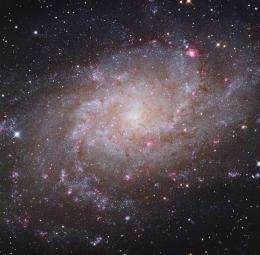The Supernovae of Triangulum

(PhysOrg.com) -- The Triangulum Galaxy, at a distance of only 2.6 million light-years, is one of the closest spiral galaxies to earth. It is also the third largest member of our galactic neighborhood (after Andromeda and our own Milky Way).
Because we see it nearly face on and so have such a clear view of its stars, it has long been an obvious choice for astronomers wanting to characterize the complete population of supernovae in a galaxy.
Supernovae are the explosive deaths of massive stars. These cataclysms disburse into space all the chemical elements produced by the nuclear reactions inside the progenitor stars, and chemical enrichment alone is reason enough to make supernovae objects of intense study. In addition, though, supernovae are so bright that they can be seen at very large (cosmological) distances. If a supernova's intrinsic brightness is known from its basic character, its distance (and the distance of its host galaxy) can be determined from its apparent brightness. This presumes that we understand supernovae and their possible varieties. By studying the character of an entire population of supernovae in a single galaxy, like the Triangulum, and the remnants they leave behind, astronomers can test and refine their understanding of supernovae.
In the Milky Way there have been at least five supernovae in the last thousand years or so. All of their remnants are detectable today as X-ray sources, and their differing properties reflect their diverse characters. For example, while four these five remnants have comparatively modest gas temperatures, the Crab Nebula remnant hosts a pulsar and its gas is much hotter. CfA astronomers Terrance Gaetz, Bob Kirshner, Paul Plucinsky, and Ralph Tullmann, together with a team of twelve colleagues, used the Chandra X-ray Observatory to undertake the first deep X-ray study of the Triangulum Galaxy.
The scientists detected eighty-two of the 137 known supernova remnants, making this the largest sample of supernova remnants detected both in optical and X-rays in any galaxy, including the Milky Way. They developed a new morphological classification scheme to relate optical and X-ray sources, reported that they find no direct analogs to some of the bright, recent remnants in the Milky Way, and concluded that there are no strong correlations between the X-ray brightness of these remnants and their brightnesses at other wavelengths. The results refine our basic understanding of supernovae, and help clarify the range of X-ray properties they have.
Provided by Harvard-Smithsonian Center for Astrophysics



















